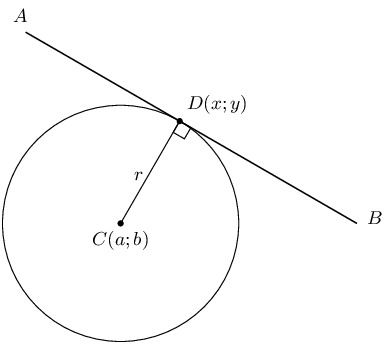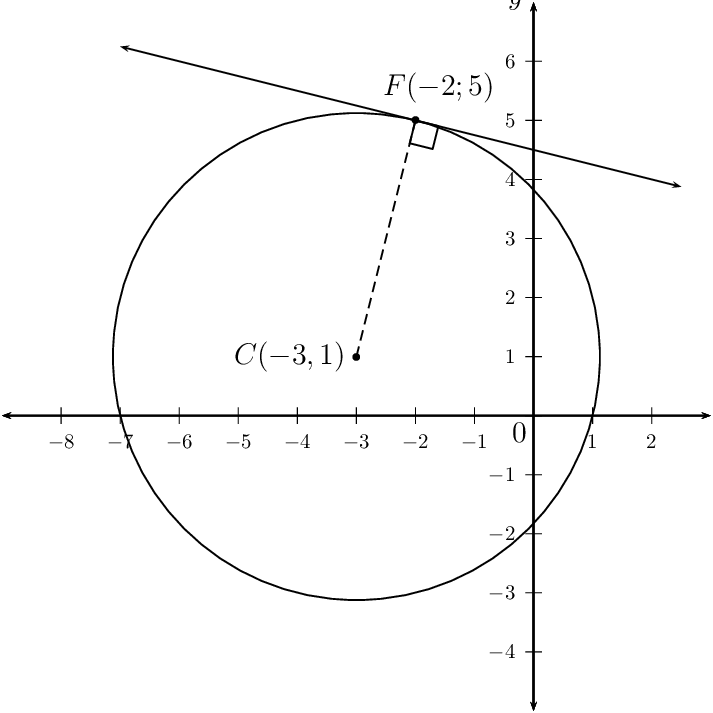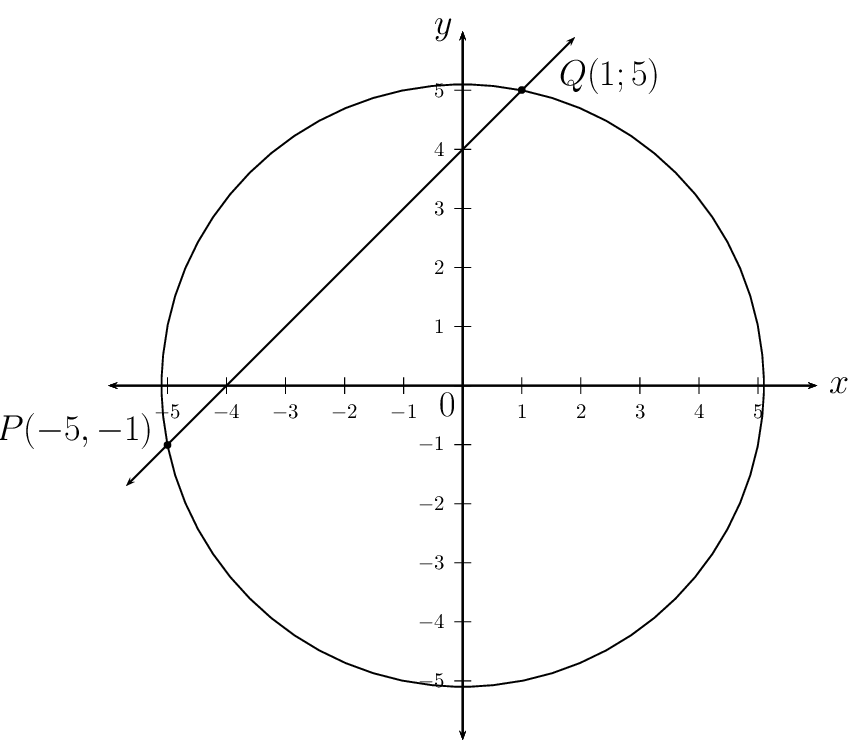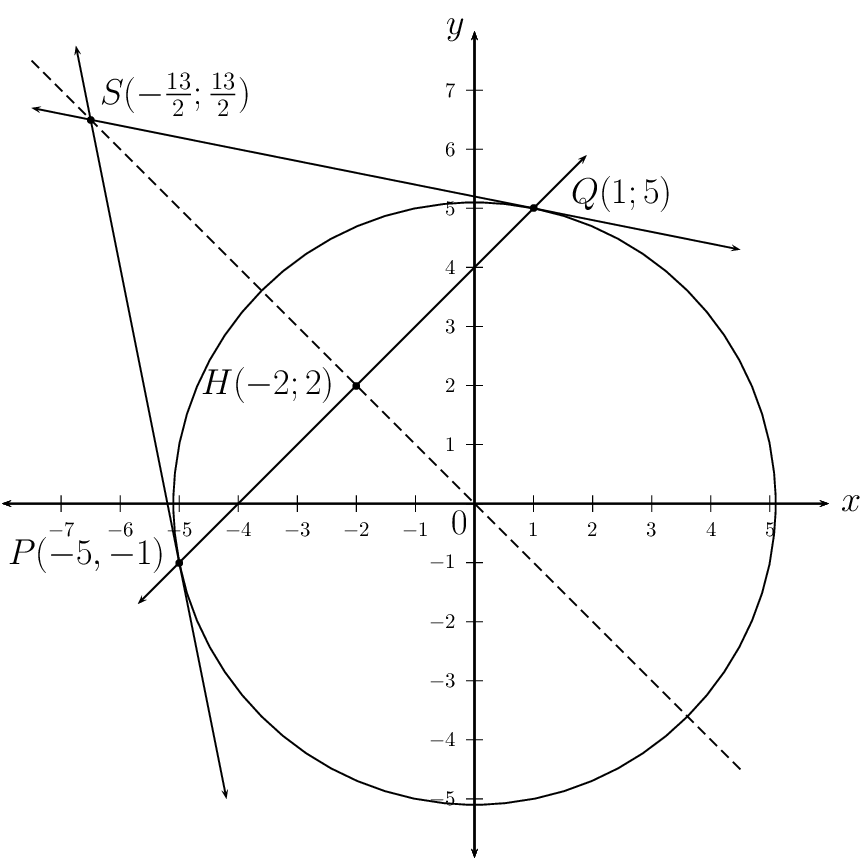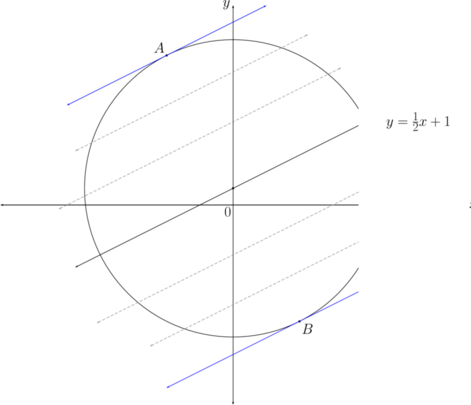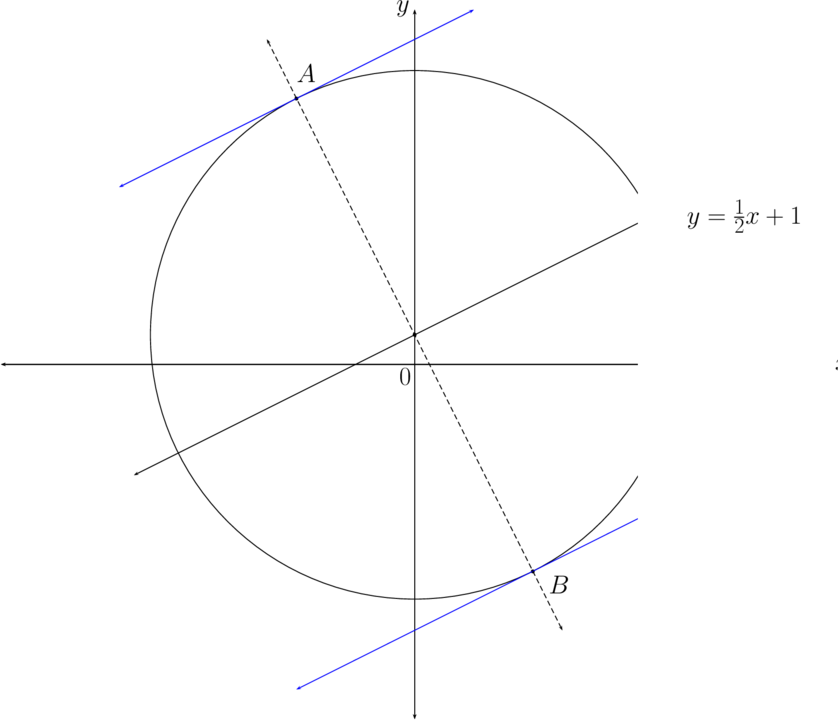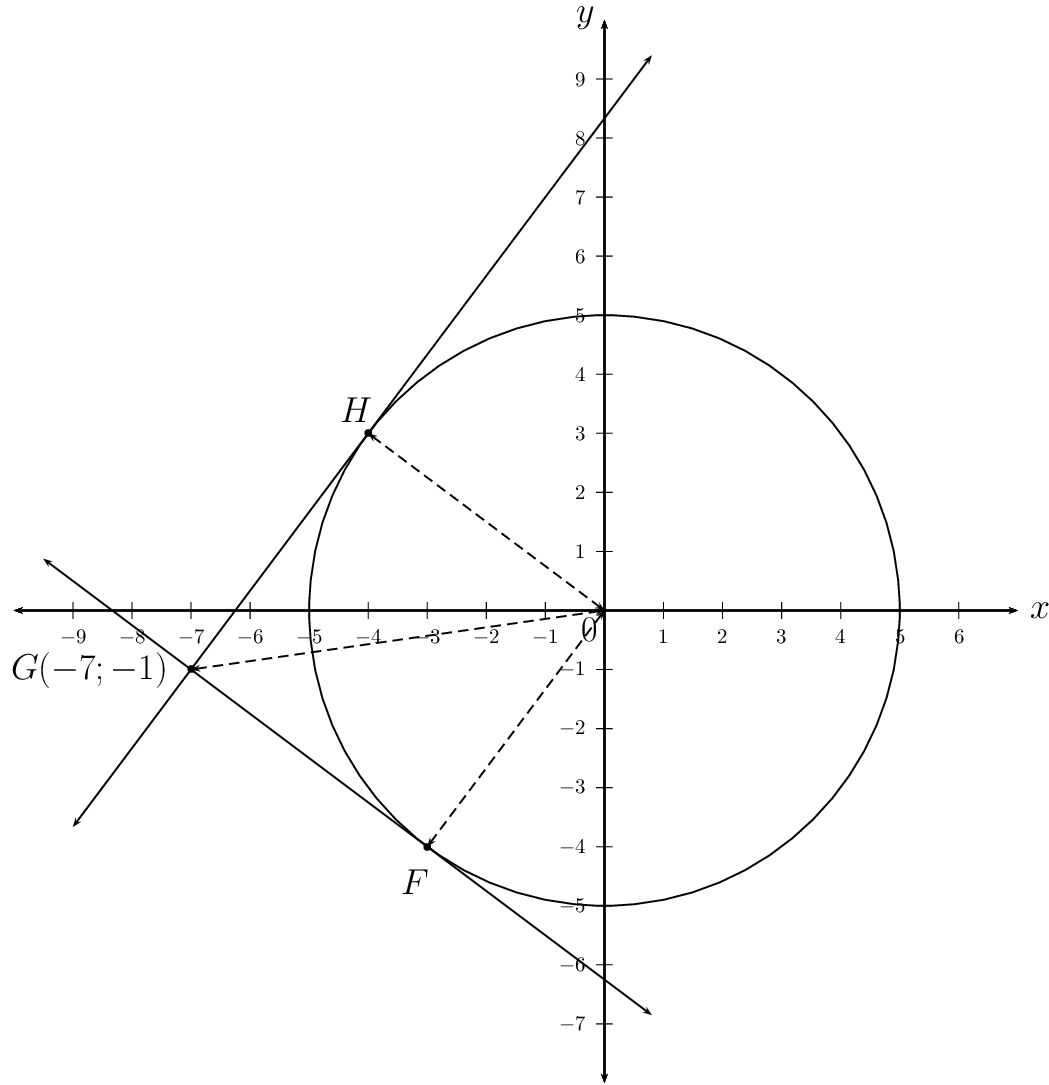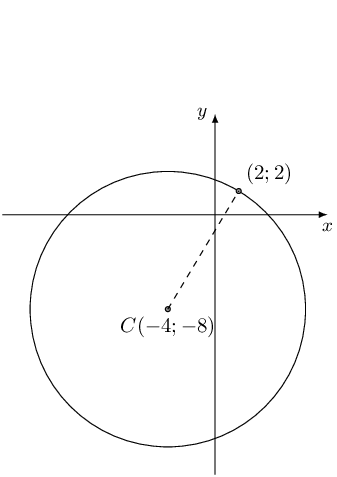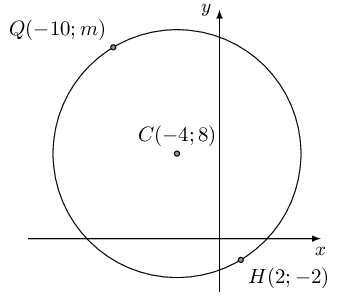Calculate the coordinates of \(P\) and \(Q\).
Substitute the straight line \(y = x + 2\) into the equation
of the circle and solve for \(x\):
\begin{align*}
x^{2} + y^{2} &= 20 \\
x^{2} + (x + 2)^{2} &= 20 \\
x^{2} + x^{2} + 4x + 4 &= 20 \\
2x^{2} + 4x - 16 &= 0 \\
x^{2} + 2x - 8 &= 0 \\
(x - 2)(x + 4) &= 0 \\
\therefore x = 2 &\text{ or } x = -4 \\
\text{If } x = 2 \quad y &= 2 + 2 = 4 \\
\text{If } x = -4 \quad y &= -4 + 2 = -2
\end{align*}
This gives the points \(P(-4;-2)\) and \(Q(2;4)\).
Determine the length of \(PQ\).
\begin{align*}
PQ &= \sqrt{(x_{2} - x_{1})^{2} + (y_{2} - y_{1})^2} \\
&= \sqrt{(-4 -2)^{2} + (-2-4 )^2} \\
&= \sqrt{(-6)^{2} + (-6)^2} \\
&= \sqrt{36 + 36} \\
&= \sqrt{36 \cdot 2} \\
&= 6\sqrt{2}
\end{align*}
Determine the coordinates of \(M\), the mid-point
of chord \(PQ\).
\begin{align*}
M(x;y) &= \left( \frac{x_{1} + x_{2}}{2}; \frac{y_{1} +
y_{2}}{2} \right) \\
&= \left( \frac{-4 + 2}{2}; \frac{-2 + 4}{2} \right) \\
&= \left( \frac{-2}{2}; \frac{2}{2} \right) \\
&= \left( -1; 1 \right)
\end{align*}
If \(O\) is the centre of the circle, show that
\(PQ \perp OM\).
\begin{align*}
m_{PQ} &= \frac{4 - (-2)}{2 - (-4)} \\
&= \frac{6}{6} \\
&= 1 \\
& \\
m_{OM} &= \frac{1 - 0}{-1 - 0} \\
&= - 1 \\
m_{PQ} \times m_{OM} &= - 1 \\
& \\
\therefore PQ & \perp OM
\end{align*}
Determine the equations of the tangents to the
circle at \(P\) and \(Q\).
Tangent at \(P\):
Determine the gradient of the radius \(OP\):
\begin{align*}
m_{OP} &= \frac{y_{2} - y_{1}}{x_{2}- x_{1}} \\
&= \frac{-2 - 0}{- 4 - 0} \\
&= \frac{1}{2}
\end{align*}
Let the gradient of the tangent at \(P\) be \(m_{P}\). The
tangent of a circle is perpendicular to the radius,
therefore we can write:
\begin{align*}
m_{OP} \times m_{P} &= -1 \\
\frac{1}{2} \times m_{P} &= -1 \\
\therefore m_{P} &= - 2
\end{align*}
Substitute \(m_{P} = - 2\) and \(P(-4;-2)\) into the equation
of a straight line.
\begin{align*}
y - y_{1} &= m (x - x_{1}) \\
y - y_{1} &= - 2 (x - x_{1}) \\
\text{Substitute } P(-4;-2): \quad y + 2 &= - 2 (x + 4) \\
y &= -2x - 8 - 2 \\
&= -2x - 10
\end{align*}
Tangent at \(Q\):
Determine the gradient of the radius \(OQ\):
\begin{align*}
m_{OQ} &= \frac{y_{2} - y_{1}}{x_{2}- x_{1}} \\
&= \frac{4 - 0}{2 - 0} \\
&= 2
\end{align*}
Let the gradient of the tangent at \(Q\) be \(m_{Q}\). The
tangent of a circle is perpendicular to the radius,
therefore we can write:
\begin{align*}
m_{OQ} \times m_{Q} &= -1 \\
2 \times m_{Q} &= -1 \\
\therefore m_{Q} &= - \frac{1}{2}
\end{align*}
Substitute \(m_{Q} = - \frac{1}{2}\) and \(Q(2;4)\) into the
equation of a straight line.
\begin{align*}
y - y_{1} &= m (x - x_{1}) \\
y - y_{1} &= - \frac{1}{2} (x - x_{1}) \\
\text{Substitute } Q(2;4): \quad y - 4 &= - \frac{1}{2} (x -
2) \\
y &= - \frac{1}{2}x + 1 + 4 \\
&= - \frac{1}{2}x + 5
\end{align*}
Therefore the equations of the tangents to the circle are \(y
= -2x - 10\) and \(y = - \frac{1}{2}x + 5\).
Determine the coordinates of \(S\), the point where
the two tangents intersect.
Equate the two linear equations and solve for \(x\):
\begin{align*}
-2x - 10 &= - \frac{1}{2}x + 5 \\
-4x - 20 &= - x + 10 \\
-3x &= 30 \\
x &= - 10 \\
\text{If } x = - 10 \quad y &= - 2 \left( - 10 \right) - 10
\\
&= 10
\end{align*}
This gives the point \(S \left( - 10;10 \right)\).
Show that \(PS = QS\).
\begin{align*}
PS &= \sqrt{(x_{2} - x_{1})^{2} + (y_{2} - y_{1})^2} \\
&= \sqrt{(-4 -(-10))^{2} + (-2 - 10)^2} \\
&= \sqrt{(6)^{2} + (-12)^2} \\
&= \sqrt{36 + 144} \\
&= \sqrt{180}
\end{align*}
\begin{align*}
QS &= \sqrt{(x_{2} - x_{1})^{2} + (y_{2} - y_{1})^2} \\
&= \sqrt{(2 -(-10))^{2} + (4 - 10)^2} \\
&= \sqrt{(12)^{2} + (-6)^2} \\
&= \sqrt{144 + 36} \\
&= \sqrt{180}
\end{align*}
Determine the equations of the two tangents to the
circle, both parallel to the line \(y + 2x = 4\).
The tangent at \(P\), \(y = -2x - 10\), is parallel to \(y =
- 2x + 4\). To find the equation of the second parallel
tangent:
\begin{align*}
y &= -2x + 4 \\
\therefore m &= -2 \\
\therefore m_{\text{radius}}&= \frac{1}{2} \\
\text{Eqn. of radius: } y &= \frac{1}{2}x \ldots(1) \\
\text{Substitute } (1): \quad x^{2} + y^{2} &= 20 \\
x^{2} + \left( \frac{1}{2}x \right)^{2} &= 20 \\
x^{2} + \frac{1}{4}x^{2} &= 20 \\
\frac{5}{4}x^{2} &= 20 \\
x^{2} &= 16 \\
x &= \pm 4 \\
\text{If } x = 4, y &= 2 \\
\text{Substitute } (4;2): \quad y &= -2x + c \\
2 &=-2(4) + c \\
10 &= c \\
y &= -2x + 10
\end{align*}

